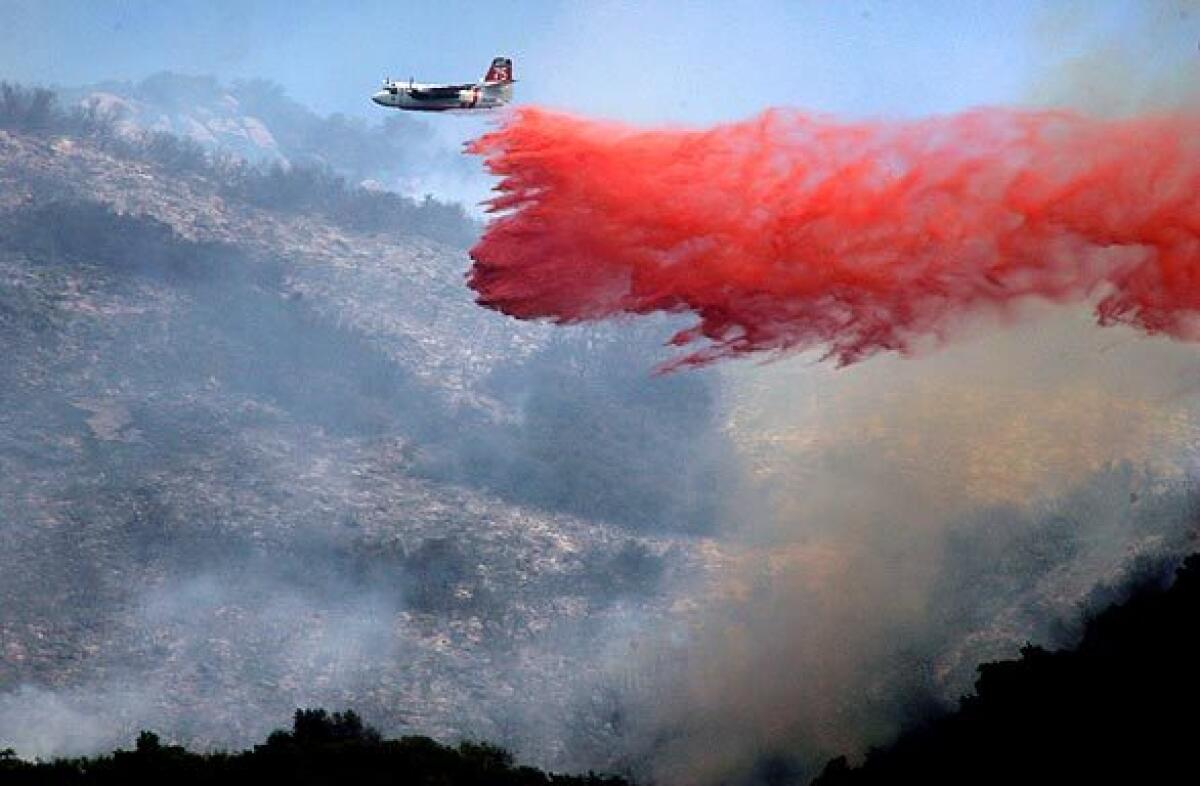Push is on to stall Goleta fire before winds; more evacuations at Big Sur

A fire has reached as close as 2 miles to populated areas of Goleta today after burning through 200 to 300 acres in Los Padres National Forest since Tuesday evening, authorities said.
Meanwhile, the stubborn Big Sur blaze jumped a containment line this morning, forcing more evacuations there and shutting down Highway 1 -- the area’s chief road -- for 30 miles. The development was a setback not just for local residents but for a number of famed resorts and restaurants that had been in harm’s way earlier but reopened in the past few days.
The community of Big Sur was evacuated, and landmarks like the Ventana Inn and the Post Ranch Inn shut their doors today as the notoriously unpredictable fire raged.
“It seems to be giving the fire guys conniption fits,” said Darby Marshall, a spokesman for the Monterey County Office of Emergency Services. “It’s doing things they normally wouldn’t expect.”
In Goleta, Santa Barbara County Fire Capt. Eli Iskow said light winds have helped firefighters this morning, but there’s great concern about stronger winds forecast for this afternoon, and possibly powerful and erratic “sundowner” winds.
So firefighters are hitting the flames hard, with four helicopters and four air tankers.
“The wind is in our favor and we are taking advantage of that by dropping everything we’ve got on it,” Iskow said. “We’re trying to stay ahead of the flames before the winds arrive.”
About 300 homes are downhill of the flames, Iskow said, but is burning entirely within national forest land.
Nearly 200 firefighters are battling the fire, including crews from the city of Los Angeles, and Los Angeles and Ventura counties.
“Everybody’s helping each other without question, but we all know that if they have a fire in their own area they’ll be taking off,” he said while expressing gratitude for the assistance.
Today’s fire is burning about two miles west of the path of the 1990 Painted Cave Fire, which burned 600 structures in 90 minutes.
Celia Breyfogle, 75, and her husband Newell, 78, walked up to the corner of Cathedral Oaks Boulevard and La Patera Lane to view the advancing flames this morning. Helicopters dropping fire retardant and water whirred above plumes of beige smoke.
“As long as the winds don’t blow, I think we’ll be all right,” said Newell Breyfogle.
The Breyfogles said they have several friends who lost their homes in 1990, and that they have already boxed up clothing, pictures and documents in case they have to flee.
“They told us to be ready to evacuate,” said Celia Breyfogle, who added: “It’s been a terrible year. The Midwest is getting water, water, water, and we’re getting fire, fire, fire. Wish we could all share,” she said.
Motorists on the 101 Freeway this morning could see fingers of smoke working their way down the mountain.
The blaze, which is being called the Gap Fire, started about 5:45 p.m. Tuesday on a ridge in the Santa Barbara County city of Goleta but the cause remains unknown.
The evacuation order, still in effect today, was mandatory in Glen Annie and La Patera canyons, and an evacuation warning was issued for residents above Cathedral Oaks Road, between Glen Annie Road and Fairview Avenue.
Iskow said about 40 homes were evacuated. A shelter was opened at San Marcos High School in Santa Barbara for residents and their small pets.
Firefighters also continue to battle numerous wildfires that have burned more than 440,000 acres in Northern California, including a blaze that has charred homes and threatened tourist haunts along the Big Sur coast.
Statewide, 7,800 homes remain threatened and 31 residences have been destroyed.
On Tuesday, Gov. Arnold Schwarzenegger ordered the California National Guard to deploy ground forces for the first time in three decades to help weary firefighters battling blazes from Kern County to the Oregon border.
Flames dogged the Big Sur coast in Los Padres National Forest, where they have destroyed 16 coastal homes and continue to threaten 1,200 more residences and some famed local institutions.
U.S. Forest Service officials ordered about 200 people along a sparsely populated, 20-mile stretch of coast south of the town of Big Sur to evacuate late Tuesday afternoon as a precaution to allow controlled burns intended to solidify containment lines, said John Ahman, a spokesman for the agency. Among the spots evacuated, he said, were the Esalen Institute and the Immaculate Heart Hermitage.
California Highway 1 now is closed from Limekiln State Park to Andrew Molera State Park. Maia Carroll of the Monterey County Office of Emergency Services said the area under the new evacuation area is thought to have about 850 people living in it. “We know a lot of people have remained behind -- that’s just the way they live,” she said. “But we’re worried for them.”
Also in the Big Sur area, containment lines were being laid down to hem in the Basin Complex fire, which has proved to be the most destructive of the more than 1,400 lightning-sparked fires that have racked the northern part of the state since June 21.
Of the 31 homes destroyed statewide in the blazes, most were nestled on the panoramic hillsides rising from the Big Sur coast.
In recent days, weather helped firefighters in Big Sur to control the blaze, which has charred nearly 50,000 acres. Fog is expected through the week, and winds from the north continued to push the blaze back on itself, slowing its march toward the region’s most populated areas.
“I would say we’re cautiously optimistic with the current conditions,” Ahman said. “With the marine layer and light winds, we haven’t had any huge runs by the fire.”
But those same winds could turn problematic in coming days. The breezes are expected to pick up through Thursday, with gusts blowing from the north at up to 20 mph, potentially whipping up the blaze anew.
The winds also could push the fire deeper into the Ventana Wilderness and toward the remote outpost of Tassajara Hot Springs, where the Buddhist monks of the Tassajara Zen Mountain Center have been preparing for days to fight the flames along with Forest Service crews.
The fire’s northeast flank also is edging perilously close to a cabin owned an octogenarian backwoodsman named Jack English. In recent days, English had refused entreaties by law enforcement and fire officials to evacuate his remote homestead in Pine Valley, more than 4 miles from the nearest public dirt road.
Ahman said there are areas of fire so deep in the forest that they are virtually impossible to fight except with helicopters or fixed-wing aircraft.
“There are areas where you just can’t put in people, so it becomes an air show or perhaps a few repellers dropped from helicopters,” he said.
Although the Basin Complex fire remains less than 5% contained, an even bigger blaze burning to the east in Los Padres National Forest is expected to be fully controlled by Thursday, fire officials said.
In other parts of Northern California, more than 100 of the fires ignited by the lightning barrage 10 days ago continued to burn, though authorities said they were getting the upper hand.
Firefighters from the California Department of Forestry and Fire Protection have contained scores of fires and made good progress on many others, said spokesman Daniel Berlant.
“We got through this last weekend without more problems from lightning, and the injury count and destruction remains extremely low given the number of fires and acres burned,” he said.
About 200 Guardsmen will be deployed to help with hand crews -- a move that Schwarzenegger described as a “big shot in the arm” to the professional fire teams that have been battling blazes on and off for the last six weeks.
Brig. Gen. Kevin Ellsworth said soldiers from as far south as Santa Barbara will be trained for five days in the forests of Mendocino County, where scores of fires are still burning, and then deployed for three to four weeks to help mop up the blazes.
It marks the first time since 1977 that National Guard ground troops have been used to fight fires. The Guard’s aerial fleet, including Black Hawk helicopters out of Los Alamitos, has been fighting the fires for more than a week.
Also, the California Conservation Corps has in recent days sent nearly 800 young workers to help fight the blazes. It is the largest such firefighting deployment in the organization’s history, said David Muraki, the agency’s director.
“This is a major natural disaster,” Berlant said, describing one of the most widespread firefighting deployments in California history.
Nearly 19,000 firefighters from California and 41 other states have been on the front lines of the blazes, helped by more than 1,400 fire engines and scores of aircraft.
One result has been mounting costs. The tab for fighting the Big Sur blazes alone probably will soon top $50 million, according to the Forest Service.
Times Staff Writer Francisco Vara-Orta contributed to this report.
Sign up for The Wild
We’ll help you find the best places to hike, bike and run, as well as the perfect silent spots for meditation and yoga.
You may occasionally receive promotional content from the Los Angeles Times.




